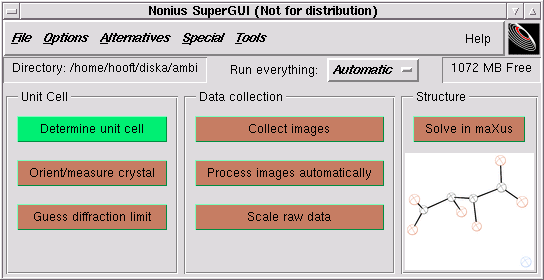12) Determine the resolution limit of diffraction.
Click on "Guess diffraction limit" in the SuperGUI window:

A small window appears telling you that the ten images are being read. The program lists what it finds in the "collect text output" window, and then displays a window something like this:

Typical small-molecule data collections using Mo Kα radiation go out as far as 55° in 2θ (27.5° in θ!), which corresponds to 0.77Å resolution. If diffraction is weak you may want to cut the high-resolution angle limit to 25° in theta, which is about 0.83Å resolution. If you remember Bragg's Law you can work this all out yourself.
You get to set these parameters later, so make a mental note of whether you intend to change the maximum diffraction angle and/or scan time.
Notice that the above message states "Overflows could appear above 10 seconds per degree". CCD detectors have a large, but limited dynamic range, which means that it is possible to overload the detector. This can (and does) happen for the most intense reflections, so it is best to be aware of the problem. For this reason, in addition to the regular data collection run, it is wise to collect a fast scan (e.g. 360° in φ) to ensure that the most intense data are recorded properly. We'll get to that in the next section of this tutorial. This extra scan can be scaled and merged later to give a complete dataset.
If you don't know what these numbers mean, you should not be attempting to operate the diffractometer on your own!
Return to the main Tutorials page or to the main X-Ray Lab page